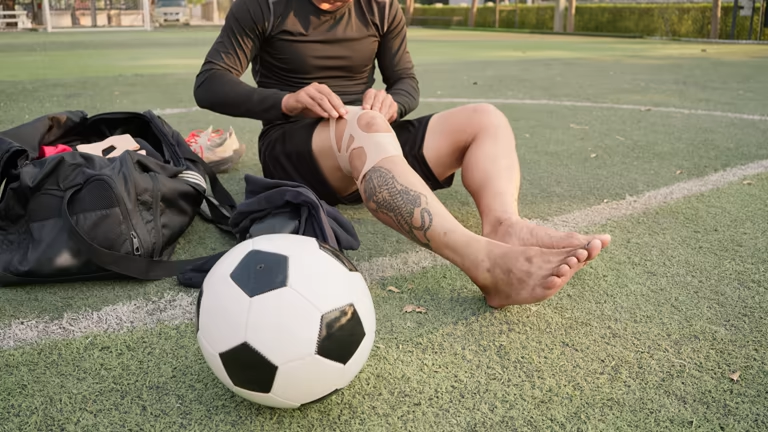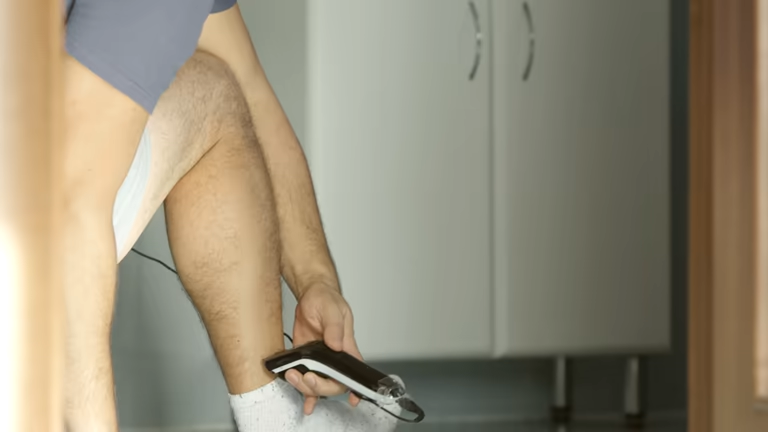If you’ve ever watched a professional soccer match up close or caught glimpses of players during training, you might have noticed something curious: many of them have surprisingly smooth, hairless legs. No, it’s not just a fad or a quirky fashion choice.
Shaved legs have quietly become the norm in soccer, sparking questions from fans and curious observers alike.
Why are so many soccer players suddenly reaching for razors? Is it all about looks, or is there something deeper behind the smooth surface?
As it turns out, the decision to shave their legs is far from superficial.
For most players, it’s rooted in functionality, comfort, and performance factors that can have a real impact on how they train, recover, and compete on the pitch.
From handling injuries and improving massage therapy to minor performance gains and even aesthetics, leg shaving has a surprising number of practical benefits.
In this article, we’ll break down exactly why soccer players shave their legs: from injury prevention to massage benefits to minor performance gains.
- 1. Injury Treatment and Prevention
- 2. Emergency Treatments During Matches
- 3. Better Massage Experience
- 4. Improved Performance (Even If Just Slightly)
- 5. Compatibility with High Socks and Shin Guards
- 6. Style and Personal Preference
- 7. Team Culture and Peer Influence
- 8. Faster Recovery and Muscle Treatment
- 9. Reducing Turf Burn and Skin Irritation
- 10. It’s Just Easier
- Is Leg Shaving Here to Stay?
1. Injury Treatment and Prevention
One of the most common and practical reasons soccer players shave their legs is to make it easier to treat injuries. Soccer is a high-contact, high-intensity sport, and players frequently deal with bruises, cuts, scrapes, sprains, and muscle strains.
Be it an ankle needing tape or a thigh requiring a compression wrap, having smooth skin makes application (and removal) of these treatments easier and less painful.
Taping and Bandaging Made Easier

Taping is used extensively in soccer. Athletic trainers tape ankles, calves, thighs, and knees to provide extra support or prevent re-injury.
Now, imagine applying sticky medical tape to a thick patch of leg hair. Not only does the hair interfere with adhesion, but removing the tape later becomes an excruciating process, like waxing, but worse.
Shaved legs eliminate that problem.
The tape goes on smoothly and comes off cleanly, without pulling at the skin or hair. This is especially important during games when quick taping jobs are needed on the fly.
Hygiene and Infection Control
Shaving can also help with hygiene.
When you have a wound covered in tape or a bandage, hair can trap sweat and bacteria, increasing the risk of infections. A clean-shaven area is easier to keep sterile, and the tape adheres better to smooth skin.
In sports medicine, minimizing bacterial buildup is crucial, especially when players are sweating heavily, sliding on dirty pitches, or exposed to turf burns and abrasions.
2. Emergency Treatments During Matches
Soccer is a fast-moving game, and there’s little time to pause. When a player gets injured during a match, the treatment has to be fast, efficient, and effective.
That could mean applying ice packs, compression sleeves, or even cutting away socks to get to the skin quickly.
In some cases, players may need to shave a portion of the leg on the spot to apply tape or medication. Rather than endure this in the heat of the moment, many players proactively shave their legs before the game.
That way, there’s no delay in treating injuries or discomfort when the tape is applied.
It’s a small change that makes a big difference in terms of preparedness and responsiveness.
SEE ALSO | Top 10 Premier League Stadiums
3. Better Massage Experience

Massages are an essential part of a soccer player’s routine, both before and after matches. Pre-match massages help warm up muscles, loosen tight areas, and improve blood flow.
Post-match massages reduce soreness, aid in recovery, and prevent injuries from lingering.
Less Discomfort, More Relief
Massaging a hairy leg can be uncomfortable. Oils, lotions, and deep strokes can pull on the hair, causing irritation or even pain: something no player wants after a 90-minute match. Shaved legs, on the other hand, provide a smooth surface for therapists to work with.
The massage becomes more effective, and players are less likely to experience discomfort.
Therapists can apply deeper pressure without resistance from hair, and the player receives maximum recovery benefits.
For professional players getting massages multiple times a week, shaved legs are a no-brainer.
4. Improved Performance (Even If Just Slightly)
You’ve prolly heard of swimmers shaving their bodies to reduce drag in the water. While soccer isn’t a water sport, some players believe that shaving their legs gives them a slight edge in performance, either physically or mentally.
The Aerodynamic Factor
Hair adds a bit of drag, even on land. While this may not be significant enough to impact sprint speeds noticeably, some players still value any potential advantage, no matter how small.
Smooth legs may move through compression shorts or slide more easily against socks and shin guards, allowing for greater comfort and mobility.
Psychological Boost
For others, it’s mental. When you look good and feel sleek, you perform better. That’s not vanity, it’s confidence. Players are known to thrive on routine and superstition, and if shaving legs helps them feel faster or more in control, then it becomes part of their ritual.
Even if the performance benefit is mostly psychological, if it helps players get into the right mindset, it’s worth it.
SEE ALSO | How to Keep Soccer Kids Active During School Breaks
5. Compatibility with High Socks and Shin Guards
Every soccer player wears high socks and shin guards, and these items hug the legs tightly for the full 90 minutes.
Hair can cause friction between the skin and the gear, leading to irritation or even ingrown hairs.
Shaved legs are more comfortable under socks, especially when playing in hot or humid conditions. They reduce chafing, overheating, and skin irritation.
For players who wear compression sleeves, tape, or wraps, hairless skin also ensures a more snug, comfortable fit.
Plus, if you’ve ever had to rip off a tight sock or remove shin guards after a match and felt your leg hair come with it, you’ll understand why many players prefer to skip the pain and just shave.
6. Style and Personal Preference

Let’s not ignore the aesthetic aspect. Some soccer players just like the look of smooth, toned legs. And who can blame them?
With the amount of physical training they go through, soccer players often have well-defined legs they’re proud of.
Maybe the shaving started for practical reasons like injury management or massage therapy, but it became part of their identity.
For others, shaving is just a style choice, similar to having a specific haircut, wearing flashy cleats, or rocking a signature celebration.
As grooming standards change and more men embrace personal care routines, shaving legs isn’t unusual. It’s become quite normal in sport world just another part of the toolkit to feel good, look good, and play good.
SEE ALSO | 20 Must-Watch Soccer Documentaries That Will Inspire You
7. Team Culture and Peer Influence
In locker rooms across the world, soccer players influence each other’s routines. When a team’s veterans or star players shave their legs, younger teammates might follow suit.
Sometimes it’s out of respect. Other times, it’s out of curiosity.
Team culture can play a big role in how grooming habits develop. If the entire squad is clean-shaven, you might feel out of place showing up with hairy legs.
And since there are practical benefits, most players don’t mind joining in.
Over time, it becomes a team norm, something expected rather than questioned.
8. Faster Recovery and Muscle Treatment
Compression therapy has become a regular part of elite recovery routines.
Players often wear tight sleeves or pants post-match to reduce inflammation and speed up muscle healing. These garments are far more effective on smooth skin.
Hair can create resistance, disrupt compression uniformity, and trap sweat or bacteria. Shaved legs ensure that the gear fits snugly and does its job, stimulating circulation and minimizing muscle soreness after intense activity.
Shaved legs also benefit players who undergo regular physiotherapy or cold therapy. Whether they’re using cryo-chambers, ice baths, or electrical stimulation, hairless skin improves comfort and effectiveness.
SEE ALSO | Must-Have Supplements For Soccer Players – 7 Effective Choices
9. Reducing Turf Burn and Skin Irritation
Artificial turf is becoming more common in training grounds and stadiums, but it’s notorious for causing turf burns, abrasions that occur when the skin slides against synthetic grass. These burns are painful and prone to infection.
Hair traps dirt, sweat, and bacteria around the wound, increasing the risk of irritation and slowing down the healing process.
Shaving legs makes it easier to treat and clean turf burns. And once again, bandages stick better to smooth skin.
Players who regularly train or play on artificial turf often adopt shaving as a preventative strategy.
10. It’s Just Easier
When all is said and done, shaving your legs as a soccer player just makes life easier. You get better treatment, smoother massages, faster recovery, fewer infections, less irritation, and easier taping. It’s a small effort with a big payoff.
What started as a functional decision becomes a habit and then a routine. And like many things in sports, routines are sacred. If something works, players stick with it.
SEE ALSO | How to Choose the Right College Soccer ID Camp
Is Leg Shaving Here to Stay?
Shaved legs aren’t just a fad in soccer, they’re here to stay. As sports science continues to evolve, and recovery becomes as important as training itself, leg shaving is likely to remain a standard part of a soccer player’s toolkit.
With benefits spanning injury care, massage effectiveness, comfort, and even confidence, the case for shaving is strong.
Plus, with the growth of personal grooming trends among men and athletes across all sports, there’s no stigma attached anymore.
Sure, not every player will embrace it.
Some prefer the natural look or don’t feel the need. But for those who do, it’s much more than a cosmetic decision, it’s a game-day advantage, a recovery strategy, and a performance-enhancing habit.
Final Thoughts
So, why do soccer players shave their legs? The better question might be, why not?
From reducing tape pain and preventing infection to improving massage comfort and supporting recovery, leg shaving offers real-world benefits that go beyond appearance. It’s practical, purposeful, and increasingly popular in today’s game.
SEE ALSO | How to Be More Than a Soccer Parent – Support, Motivate, and Inspire
SEE ALSO | 5 Exciting 1 v 1 Soccer Drills for Youth Players to Improve Skills



